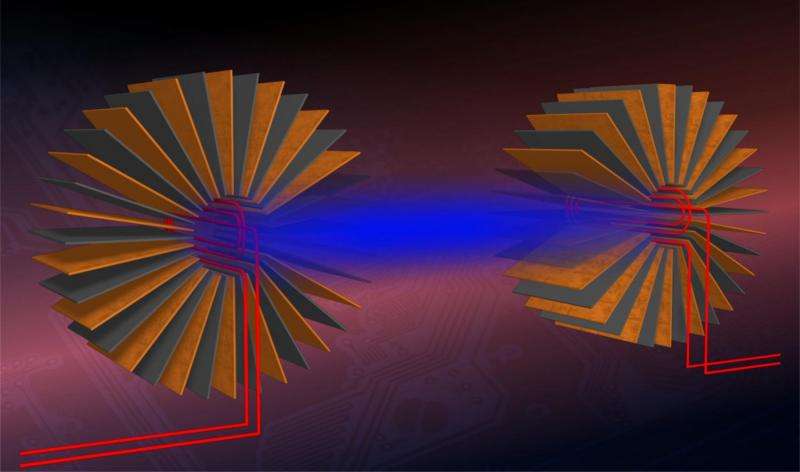Schematic diagram of the experimental setup used to transfer energy between two circuits, developed by UAB researchers. Credit: Jordi Prat
Universitat Autònoma de Barcelona researchers have developed a system that efficiently transfers electrical energy between two separate circuits. The system, made with a shell of metamaterials that concentrates the magnetic field, could transmit energy efficiently enough to charge mobile devices without having to place them close to the charging base. The research was published in the journal Advanced Materials.
Wireless charging of mobile devices is a future technological milestone. Some devices can already be charged wirelessly via the use of a charging base. The next step is developing devices that charge without such bases.
A group of researchers from the Department of Physics of Universitat Autònoma de Barcelona has developed a system that can efficiently transfer electrical energy between two separated circuits thanks to the use of metamaterials. This system is still in the experimental stage, but once it has been perfected and can be applied to mobile devices, it will be able to charge them wirelessly and at a longer distance than currently possible.
Today's wireless devices make use of induction to charge through a special case adapted to the device and a charging base connected to an electrical socket. The device is placed on top of the base, which generates a magnetic field inducing an electric current inside the case and, without cables, the device is charged. If the device is separated from the base, the energy is not transferred efficiently enough and the battery cannot be charged.
The system created by UAB researchers overcomes these limitations. It is made up of metamaterials that combine layers of ferromagnetic materials, such as iron compounds, and conductor materials such as copper. The metamaterials envelop the emitter and receiver and enable energy transfer at a distance and with unprecedented efficiency.
With the use of metamaterial crowns, researchers were able in the lab to increase the transmission efficiency 35-fold, "and there is much more room for improvement, since theoretically, the efficiency can be increased even more if conditions and the design of the experiment are perfected" explains Àlvar Sánchez, director of the research.
"Enveloping the two circuits with metamaterial shells has the same effect as bringing them close together; it's as if the space between them literally disappears", says Jordi Prat, lead author of the paper.
Moreover, the materials needed to construct these crowns, such as copper and ferrite, are readily available. The first experiments conducted with the aim of concentrating static magnetic fields required the use of superconductor metamaterials, unfeasible for everyday use with mobile devices. "In contrast, low frequency electromagnetic waves—the ones used to transfer energy from one circuit to the other—only need conventional conductors and ferromagnets," Navau says.
More information: Jordi Prat-Camps et al. Quasistatic Metamaterials: Magnetic Coupling Enhancement by Effective Space Cancellation, Advanced Materials (2016). DOI: 10.1002/adma.201506376
Journal information: Advanced Materials
Provided by Universitat Autonoma de Barcelona























